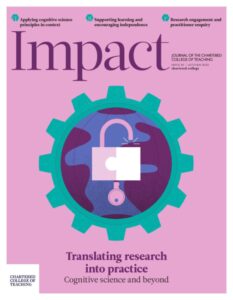Metalinguistic modelling: Applying research to practice in the ITT classroom

Laura-Jane Devanny, Senior Lecturer in Education, University of Northampton, UK
In this reflection, I discuss Myhill et al.’s (2016) research paper ‘Writing conversations: Fostering metalinguistic discussion about writing’ and how I have utilised it to facilitate application of research to practice within initial teacher trainingAbbreviated to ITT, the period of academic study and time in... More (ITTInitial teacher training - the period of academic study and ... More). This research was employed within an ITT setting when encouraging trainee teachers to critically engage with research and use evidence to critique their practice, working towards one of the requirements for professional behaviours within the ITT Core Content Framework (DfEDepartment for Education - a ministerial department responsi... More, 2019). The aim for the session was to consider prior learning and working memory as factors that impact learning and to recognise the importance of metacognition for learning, particularly given that writing can be viewed as ‘primarily a metacognitive process’ (Hacker, 2018, p. 220). The trainees then applied the knowledge gained from the research when developing their own teacher strategies for the effective teaching of primary English.
Myhill et al. (2016) conceptualise an understanding of metalinguistics that distinguishes between the different types of writerly choices, whereby ‘automated, implicit choices are linguistic, whilst rhetorical, explicit choices are metalinguistic’ (Myhill et al., 2016, p. 25). What the writers are most interested in is ‘how metalinguistic understanding supports the choices writers make’ (p. 25) and how we may develop an understanding of the benefits of metalinguistic modelling within the classroom. There is a definite sense within the research of a metacognitive model of writing, one that views writing as the object of thought and a writing process that demonstrates awareness of the structure of language (Hacker, 2018). Myhill et al.’s (2016) paper moves on to posit that talk is a ‘key mechanism’ for developing metalinguistic awareness and understanding, and the role of the teacher within this is critical’ (p. 26); for this role to be fulfilled successfully, teachers need to possess a secure level of subject knowledge. Ultimately, the key findings emphasise how talk ‘makes visible, and accessible for scrutiny, the thinking behind textual creation… implicit choices are rendered explicitly available for reflection’ (Myhill et al., 2016, p. 38).
Following a close analysis of the paper, we considered the ways in which metalinguistic discussion could impact upon memory by recapping some seminal research related to short-term working memory. Cowan’s (2021) research demonstrates that, on average, four chunks – collections of concepts that have strong associations to one another – can be held in short-term memory, revising Miller’s (1956) ‘magical number seven’. The trainees realised the implications for working memory in terms of the amount of information that we expect children to take on board in any given lesson, relating this to Sweller’s cognitive load theoryAbbreviated to CLT, the idea that working memory is limited ... More (1988); indeed, many of them were able to empathise, given the demanding level of study that they were currently undertaking as final-year university students. With these ideas in mind, we considered the terms ‘modelling’ and ‘metalanguage’ and what they might mean for developing children’s metacognition. Making comparisons with what they had witnessed on school placements, trainees were able to cite varying examples of when they had seen metalanguage teaching and modelling. There was a general consensus that breaking new material down into manageable steps before guiding through new processes was seen to generally help children towards increased metacognitive awareness, leading to an eventual level of independence. Trainees were then presented with the following question: How might metalinguistic modelling support children with learning to learn and learning to remember?
For the remainder of the session, we addressed this question through a worked example, applying knowledge to practice. Following the UK Literacy Association’s teaching model (2022), which aims to develop decision-making through an emphasis on metalinguistics and understanding of the writing process, trainees were provided with the opening pages of a model text, Ted Hughes’ The Iron Man (1968). We read and deconstructed the extract together to identify as many of the creative writing techniques as possible, which included examples of rhetorical questions, repetition, simile, personification, onomatopoeia, exclamatives, punctuation, paragraphing and sentence structure. As I began to scribe an ever-growing list of devices onto the board, the trainees quickly became overwhelmed with the amount of literary terminology with which they were being confronted. This highlighted the complexities of delivering creative writing within a primary English curriculum, which, in turn, reinforced the need to select precise learning outcomes and carefully tailor the tasks within lessons to avoid cognitive load for children. In line with the EEF recommendations (2018), classroom dialogue needs to be purposeful, with teachers guiding and supporting conversations.
Breaking into smaller groups, trainees were then asked how they might use the model text to develop children’s metalinguistic knowledge and understanding, by incorporating some of the devices within their creative writing. This required reflection on how the trainees would teach children how to learn and how to learn to remember. When teaching children how to learn, of particular importance was the promotion and development of metacognitive talk in the classroom (EEF, 2018) using metalinguistic discussion; all of the trainees chose activities involving talk to encourage children to verbalise their writerly decisions. When teaching children how to learn to remember, all of the trainees decided to focus on no more than two devices, ensuring that these devices were associated (e.g. exclamation marks alongside dashes or similes alongside personification), in order to avoid cognitive overload. The trainees’ interpretations of the task demonstrated a recognition of the importance of metacognition for learning, and their ideas for activities were designed to effectively facilitate the development of children’s metalinguistic knowledge and understanding.
The session highlighted the importance of making informed, evidence-based decisions when applying knowledge to practice, in order to design the most effective teaching strategies. Perhaps more importantly, an enhanced understanding of cognitive processes and working memory as a result of the research provided trainees with a heightened level of empathy and compassion towards the learners in their future classrooms.
- Cowan (2021) The magical number 4 in short-term memory: A reconsideration of mental storage capacity. Behavioral and Brain Sciences 24(1): 87–114.
- Department for Education (DfE) (2019) ITT Core Content Framework. Available at: https://assets.publishing.service.gov.uk/government/uploads/system/uploads/attachment_data/file/974307/ITT_core_content_framework_.pdf (accessed 27 July 2022).
- Education Endowment Foundation (EEF) (2018) Metacognition and self-regulated learning: Guidance report. Education Endowment Foundation. Available at: https://educationendowmentfoundation.org.uk/education-evidence/guidance-reports/metacognition (accessed 1 May 2022).
- Hacker DJ (2018) A metacognitive model of writing: An update from a developmental perspective. Educational Psychologist 53(4): 220–237.
- Hughes T (1968) The Iron Man: A Children’s Story in Five Nights. London: Faber and Faber.
- Miller GA (1956) The magical number seven, plus or minus two: Some limits on our capacity for processing information. Psychological Review 63(2): 81–97.
- Myhill D, Jones S and Wilson A (2016) Writing conversations: Fostering metalinguistic discussion about writing. Research Papers in Education 31(1): 23–44.
- Sweller J (1988) Cognitive load during problem solving: Effects on learning. Cognitive Science 12: 257–285.
- UK Literacy Association (UKLA) (2022) UKLA viewpoints: Writing. Available at: https://ukla.org/ukla_resources/ukla-viewpoints-writing (accessed 1 May 2022).










